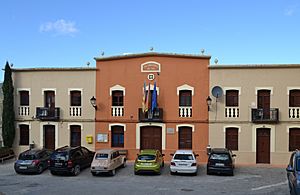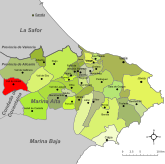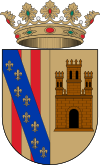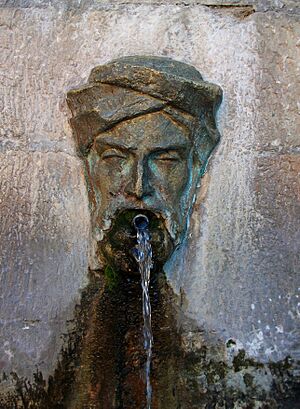La Vall d'Alcalà facts for kids
Quick facts for kids
Vall d'Alcalá
|
||
|---|---|---|
 |
||
|
||

Location of Vall de Alcalá within the Comunidad Valenciana
|
||

Location of Vall de Alcalá within Marina Alta
|
||
| Area | ||
| • Total | 24.40 km2 (9.42 sq mi) | |
| Elevation | 637 m (2,090 ft) | |
| Population
(2018)
|
||
| • Total | 164 | |
| Demonym(s) | Alcalanero, -a | |
| Official language(s) | Valencian | |
La Vall d'Alcalà is a beautiful valley in the Marina Alta region of Alicante, Spain. Its name in Spanish is Valle de Alcalá.
This area is home to two main villages: Alcalà de la Jovada and Beniaia. Long ago, there were five more villages here. Some of these old villages are now empty or in ruins. Their names were Criola, Benialí, Benixarco, La Roca, and La Adsubia (or L'Atzúvia). Don't confuse Benialí with another village of the same name in a nearby valley called Gallinera.
In 2005, about 165 people lived in Alcalà and Beniaia. Back in the 1950s, over 500 people lived here, with 642 in 1910! But in the 1960s, many families moved away. They went to bigger towns nearby like Pego, Oliva, Gandia, Muro d'Alcoi, Cocentaina, and Alcoi.
Contents
History of Vall d'Alcalà
The village of Vall d'Alcalà is famous for being the birthplace of Al-Azraq. He was a Moorish commander. In 1245, he signed an important agreement with King James I of Aragon. This agreement is known as the Al-Azraq Treaty of 1245. Locally, people call it the 'Tractat del Pouet', which means 'Treaty of the little well'. It was signed next to a small water source just outside the village.
Al-Azraq later broke this treaty in 1245 and again in 1258. He tried to defeat King James I's army but was not successful. These battles are still remembered today. Towns all over the region hold special parades called Moros i Cristians, or 'Moors and Christians'. The parades in Alcoi are the most well-known and exciting. They are even shown live on TV!
Both Alcalà and Beniaia also have their own Moors and Christians parades. These happen in August and September. They are much smaller than the big ones, but still lots of fun!
Economy and Local Products
Cherries, almonds, and olives are the main products grown and sold from Vall d'Alcalà. Many cherries bought in other countries, like the UK, actually come from this valley! The valley has its own special quality label called 'Muntanya d'Alacant'. This means its products are known for their high quality.
Meaning of the Name Alcalà
The name Alcalà comes from the Arabic word al-qal'a. This word means 'The citadel' or 'The fortress'.
Places to See and Things to Do
The village of Alcalà de la Jovada has a few places to visit. You can find three bars, a hotel, and a public swimming pool. There is also a sports area, an internet café, a cultural center (which is also a theater), and a chemist. However, there isn't a general store or supermarket in the village.
Nearby, you can explore the ruins of an old Moorish village called L'Atzuvieta. There are also two old domes called neveras (or neveres in Valencian). These were used in the past to store snow from winter. The snow would keep food cold during the warmer months. The upper one is called Nevera de Dalt, and the lower one is Nevera de Baix. The word 'nevera' is now used for a modern refrigerator. But it comes from the word for snow, nieve (or neu in Valencian).
Further down, near the village of La Vall d'Ebo, there is a cool cave. It was found in 1919 by a local hunter named José Vicente Mengual. People called him El tío Rull or 'Uncle Rull'. His dog chased a rabbit into a hole and didn't come back. Then he sent his ferret in, and it didn't come back either! So, he moved some rocks and found a cave. Inside, he saw amazing stalactites and stalagmites. This cave is officially named La Cova del Rull, after his nickname. You can visit this cave today!
The village of La Vall d'Alcalà celebrates its week-long festa (festival) usually on the first or second weekend of August. Beniaia has its own smaller festa in September.
See also
 In Spanish: Valle de Alcalá para niños
In Spanish: Valle de Alcalá para niños



